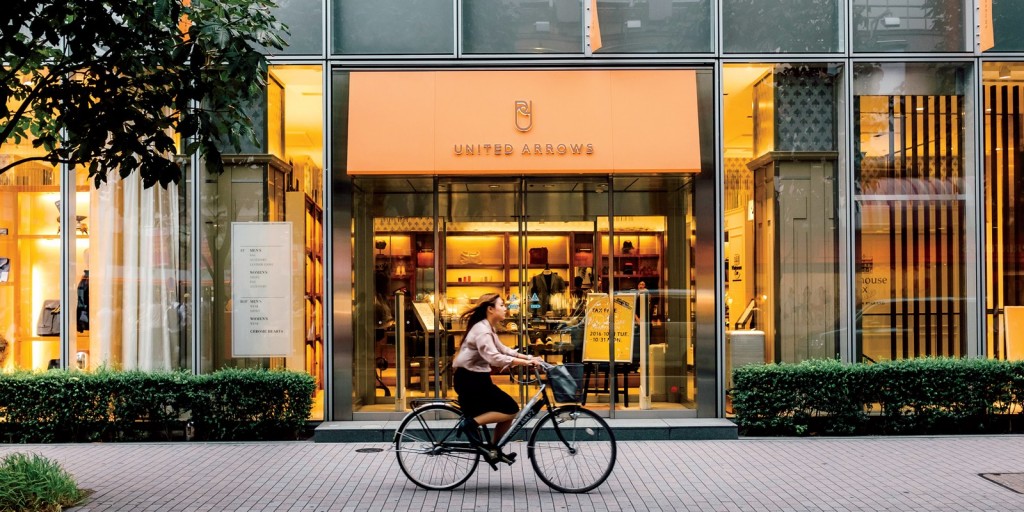TOKYO — GQ is reporting that Tokyo-based department store chain, United Arrows, globally respected as one of the best specialty retail destinations on the planet, is weighing permanent expansion into western markets.
But don’t expect a United Arrows store in Soho New York just yet. U.A.’s expansion could be several years down the road as the company, like others in Japan, waits for its shaky domestic economy to stabilize. Deliberate and meticulous, they’ll make the jump when the time is right for them.

In the meantime, consider our takeaways, based on GQ’s report, about why you should be rubbing your hands together once they do set international expansion into motion. A few notes on what makes United Arrows unique among retailers around the world…
7 Quick facts about United Arrows:
- It’s not exactly a department store chain as we know it here. Per GQ: “United Arrows is a large conglomerate of what are known in Japan as select shops — scaled-down department stores that sell brands from around the world in a boutique-like setting.”
- What’s the core of its business? Suits!
- How big is the network? 256 stores across Tokyo. Key quote: “they’re seemingly everywhere in the city, like Starbucks for high-end clothes.”
- How do they view how retail is handled in the West? Not favorably. Here’s CEO Mitsuhiro Takeda: “To be honest, I’ve rarely had a good experience shopping in the West. Some shop staffs would behave as if they were looking down on me, and that’s really bad.”
- No surprise — they treat the shopping experience very seriously (and it starts with personnel management). Per GQ: “Takeda explained…that one of the goals from the start was to offer a higher quality of life for all of its employees. ‘One of our missions was to improve the social status of our shop staffs.’ The results, as witnessed by GQ: “Every United Arrows shop [GQ] visited managed to strike a perfect balance, with a sales staff that was attentive without being overeager or pushy.”
- Their higher-ups are pure modern luxury thinkers. Here’s senior advisor to the company, Hirofumi Kurino: “The mass tendency, or mass production, or mass trend, is finished. Fashion is originally made for and stands for individual people, independent people, and we already feel this.”
- They handle celebrity well. “U.A. has a company-wide policy that celebrities are allowed to borrow and wear their clothes but are not encouraged to credit United Arrows publicly. ‘We don’t have this kind of celebrity hype,’ [CEO] Kurino said.”
Several brands in the West could learn a lot from the way U.A. handles itself…
J.Crew: J.Crew is struggling at the moment by the fact that the market, more broadly, has trended away from prep, and into activewear. That’s why you see them announcing things like men’s and and women’s activewear lines, jumping into a shallow pool that was already overcrowded.
But the farther they move away from their prep core, the weaker they become, and the less they’ll be able to enjoy the bounty of the market once prep swings back into fashion (prep never truly dies). Drexler and company would be wise to write this passage down in company HQ for all to see:
“Suits may be the most important part of United Arrows’ business, but traditional clothes are not what make waves in men’s fashion right now. Around the world, men are dressing more casually. “But that doesn’t mean we should just make more casual stuff,” Kamoshita said. “Because that’s not what we wanted to do. It would become meaningless.” Part of U.A.’s power is that even amid fashion’s constantly shifting tides, it maintains a distinct point of view. Despite the company’s size, it is as tenaciously committed to a specific mission as any of America’s best indie boutiques.”
Kit and Ace: The Wilsons might want to take some notes, given their recent missteps in global retail expansion over the last year. U.A. is playing it smart, waiting to expand internationally when the time is right. Their 256 stores have come over a span of 30 years — not three.
So-called ‘socially conscious’ brands: “There’s a satisfying honesty to [social and sustainability] projects…from United Arrows. A sense that the company isn’t merely checking off ethics boxes in order to appear as if it actually cares about something other than making as much money as possible.”






